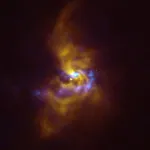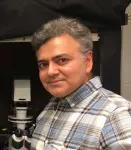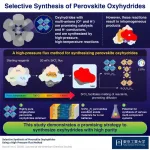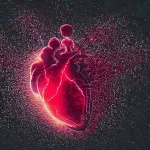(Press-News.org) A spectacular new image released today by the European Southern Observatory gives us clues about how planets as massive as Jupiter could form. Using ESO’s Very Large Telescope (VLT) and the Atacama Large Millimeter/submillimeter Array (ALMA), researchers have detected large dusty clumps, close to a young star, that could collapse to create giant planets.
“This discovery is truly captivating as it marks the very first detection of clumps around a young star that have the potential to give rise to giant planets,” says Alice Zurlo, a researcher at the Universidad Diego Portales, Chile, involved in the observations.
The work is based on a mesmerising picture obtained with the Spectro-Polarimetric High-contrast Exoplanet REsearch (SPHERE) instrument on ESO’s VLT that features fascinating detail of the material around the star V960 Mon. This young star is located over 5000 light-years away in the constellation Monoceros and attracted astronomers’ attention when it suddenly increased its brightness more than twenty times in 2014. SPHERE observations taken shortly after the onset of this brightness ‘outburst’ revealed that the material orbiting V960 Mon is assembling together in a series of intricate spiral arms extending over distances bigger than the entire Solar System.
This finding then motivated astronomers to analyse archive observations of the same system made with ALMA, in which ESO is a partner. The VLT observations probe the surface of the dusty material around the star, while ALMA can peer deeper into its structure. “With ALMA, it became apparent that the spiral arms are undergoing fragmentation, resulting in the formation of clumps with masses akin to those of planets,” says Zurlo.
Astronomers believe that giant planets form either by ‘core accretion’, when dust grains come together, or by ‘gravitational instability’, when large fragments of the material around a star contract and collapse. While researchers have previously found evidence for the first of these scenarios, support for the latter has been scant.
“No one had ever seen a real observation of gravitational instability happening at planetary scales — until now,” says Philipp Weber, a researcher at the University of Santiago, Chile, who led the study published today in The Astrophysical Journal Letters.
“Our group has been searching for signs of how planets form for over ten years, and we couldn't be more thrilled about this incredible discovery,” says team-member Sebastián Pérez from the University of Santiago, Chile.
ESO instruments will help astronomers unveil more details of this captivating planetary system in the making, and ESO’s Extremely Large Telescope (ELT) will play a key role. Currently under construction in Chile’s Atacama Desert, the ELT will be able to observe the system in greater detail than ever before, collecting crucial information about it. “The ELT will enable the exploration of the chemical complexity surrounding these clumps, helping us find out more about the composition of the material from which potential planets are forming,” concludes Weber.
More information
The team behind this work comprises young researchers from diverse Chilean universities and institutes, under the Millennium Nucleus on Young Exoplanets and their Moons (YEMS) research centre, funded by the Chilean National Agency for Research and Development (ANID) and its Millennium Science Initiative Program. The two facilities used, ALMA and VLT, are located in Chile’s Atacama Desert.
This research is presented in a paper to appear in The Astrophysical Journal Letters (doi: 10.3847/2041-8213/ace186).
The team is composed of P. Weber (Departamento de Física, Universidad de Santiago de Chile, Chile [USACH]; Millennium Nucleus on Young Exoplanets and their Moons, Chile [YEMS]; Center for Interdisciplinary Research in Astrophysics and Space Exploration, Universidad de Santiago de Chile, Chile [CIRAS]), S. Pérez (USACH; YEMS; CIRAS), A. Zurlo (YEMS; Núcleo de Astronomía, Universidad Diego Portales Chile [UDP]; Escuela de Ingeniería Industrial, Universidad Diego Portales, Chile), J. Miley (Joint ALMA Observatory, Chile; National Astronomical Observatory of Japan, Japan), A. Hales (National Radio Astronomy Observatory, USA), L. Cieza (YEMS; UDP), D. Principe (MIT Kavli Institute for Astrophysics and Space Research, USA), M. Cárcamo (YEMS; CIRAS; USACH, Faculty of Engineering, Computer Engineering Department, Chile), A. Garufi (INAF, Osservatorio Astrofisico di Arcetri, Italy), Á. Kóspál (Konkoly Observatory, Research Centre for Astronomy and Earth Sciences, Eötvös Loránd Research Network (ELKH), Hungary; CSFK, MTA Centre of Excellence, Hungary; ELTE Eötvös Loránd University, Institute of Physics, Hungary; Max Planck Institute for Astronomy, Germany), M. Takami (Institute of Astronomy and Astrophysics, Academia Sinica, Taiwan, ROC), J. Kastner (School of Physics & Astronomy, Rochester Institute of Technology, USA), Z. Zhu (Department of Physics and Astronomy, University of Nevada, USA; Nevada Center for Astrophysics, University of Nevada, USA), and J. Williams (Institute for Astronomy, University of Hawai‘i at Manoa, USA).
The Atacama Large Millimeter/submillimeter Array (ALMA), an international astronomy facility, is a partnership of ESO, the U.S. National Science Foundation (NSF) and the National Institutes of Natural Sciences (NINS) of Japan in cooperation with the Republic of Chile. ALMA is funded by ESO on behalf of its Member States, by NSF in cooperation with the National Research Council of Canada (NRC) and the National Science and Technology Council (NSTC) in Taiwan and by NINS in cooperation with the Academia Sinica (AS) in Taiwan and the Korea Astronomy and Space Science Institute (KASI). ALMA construction and operations are led by ESO on behalf of its Member States; by the National Radio Astronomy Observatory (NRAO), managed by Associated Universities, Inc. (AUI), on behalf of North America; and by the National Astronomical Observatory of Japan (NAOJ) on behalf of East Asia. The Joint ALMA Observatory (JAO) provides the unified leadership and management of the construction, commissioning and operation of ALMA.
The European Southern Observatory (ESO) enables scientists worldwide to discover the secrets of the Universe for the benefit of all. We design, build and operate world-class observatories on the ground — which astronomers use to tackle exciting questions and spread the fascination of astronomy — and promote international collaboration for astronomy. Established as an intergovernmental organisation in 1962, today ESO is supported by 16 Member States (Austria, Belgium, the Czech Republic, Denmark, France, Finland, Germany, Ireland, Italy, the Netherlands, Poland, Portugal, Spain, Sweden, Switzerland and the United Kingdom), along with the host state of Chile and with Australia as a Strategic Partner. ESO’s headquarters and its visitor centre and planetarium, the ESO Supernova, are located close to Munich in Germany, while the Chilean Atacama Desert, a marvellous place with unique conditions to observe the sky, hosts our telescopes. ESO operates three observing sites: La Silla, Paranal and Chajnantor. At Paranal, ESO operates the Very Large Telescope and its Very Large Telescope Interferometer, as well as survey telescopes such as VISTA. Also at Paranal ESO will host and operate the Cherenkov Telescope Array South, the world’s largest and most sensitive gamma-ray observatory. Together with international partners, ESO operates ALMA on Chajnantor, a facility that observes the skies in the millimetre and submillimetre range. At Cerro Armazones, near Paranal, we are building “the world’s biggest eye on the sky” — ESO’s Extremely Large Telescope. From our offices in Santiago, Chile we support our operations in the country and engage with Chilean partners and society.
Links
Research paper
Photos of the VLT
Photos of ALMA
Find out more about ESO's Extremely Large Telescope
For journalists: subscribe to receive our releases under embargo in your language
For scientists: got a story? Pitch your research
Contacts
Philipp Weber
University of Santiago
Santiago, Chile
Cell: +56966821513 / +4915759366702
Email: philipppweber@gmail.com
Alice Zurlo
Universidad Diego Portales
Santiago, Chile
Tel: +56 22138153
Email: alice.zurlo@mail.udp.cl
Sebastián Pérez
University of Santiago
Santiago, Chile
Cell: +56 9 78776812
Email: sebastian.perez.ma@usach.cl
Bárbara Ferreira
ESO Media Manager
Garching bei München, Germany
Tel: +49 89 3200 667
Cell: +49 151 241 664 00
Email: press@eso.org
END
New image reveals secrets of planet birth
2023-07-25
ELSE PRESS RELEASES FROM THIS DATE:
UBC researchers recover vital resources from wastewater sludge
2023-07-25
If you were ever to see sewage sludge up close, you might be hard-pressed to find any redeemable value; however, researchers at UBC’s Bioreactor Technology Group see it another way.
Using a combination of heat, water and phase separation, UBC researchers have developed a cost-effective method to concentrate phosphorous—which can be efficiently recovered by extraction—from wastewater sludge.
“Phosphorous is a non-renewable, but essential, element for life and has many industrial uses,” explains Huan Liu, a doctoral student with UBCO’s School of Engineering and lead author of a new study investigating ...
A new vision for US health care
2023-07-25
It’s not exactly what he’s best known for, but Alexander Hamilton helped develop the first national, compulsory health insurance policy in the world: a 1798 taxpayer-financed plan Congress approved to cover sick and disabled seamen.
“The interests of humanity are concerned in it,” Hamilton wrote.
And they still are, as MIT Professor Amy Finkelstein notes in a new book. The U.S. has repeatedly tried to provide medical care for those who need it and cannot afford it. These efforts may have started with Hamilton, but ...
Inflammation discovery could slow aging, prevent age-related diseases
2023-07-25
University of Virginia School of Medicine researchers have discovered a key driver of chronic inflammation that accelerates aging. That finding could let us slow the clock to live longer, healthier lives, and may allow us to prevent age-related conditions such as deadly heart disease and devastating brain disorders that rob us of our faculties.
So what drives this harmful inflammation? The answer is improper calcium signaling in the mitochondria of certain immune cells. Mitochondria are the power generators in all cells, ...
UK and Europe join forces for construction of largest ever European Solar Telescope
2023-07-25
**Images available**
Nine European countries, including the UK, have today (25 July 2023) joined forces to commit to the construction of the European Solar Telescope (EST)
The EST will be the biggest solar telescope ever constructed in Europe and aims to provide unparalleled new insights into the phenomena of space weather
The University of Sheffield will lead a consortium of UK universities that will help to develop designs for the construction of the large-aperture solar telescope
The first light of the EST is ...
PSMA PET imaging improves accuracy of predicting prostate cancer recurrence
2023-07-25
A molecular imaging tool developed by researchers at the University of California’s two nationally ranked medical centers, UCLA and UCSF, helps improve the accuracy of predicting the risk of cancer recurrence in patients with intermediate to high-risk prostate cancer who undergo surgery.
The tool, known as prostate-specific membrane antigen PET imaging, or PSMA PET, provides prognostic information before treatment begins that can predict if the patient will have a high risk for the cancer returning after surgery.
“In patients ...
All US racial and ethnic minority groups are underrepresented in Alzheimer’s neuroimaging research, study shows
2023-07-25
Alzheimer’s disease (AD), which affects an estimated 6.5 million adults in the United States, hits some groups harder than others. Compared to non-Hispanic whites, Hispanic Americans are 1.5 times as likely to develop AD, and African Americans are twice as likely.
But scientists know little about the reasons behind these disparities, because the vast majority of AD research has been done with non-Hispanic white people.
A new study that reviewed 11,871 research articles on AD brain imaging, led by researchers at the Keck School of Medicine of USC, has now revealed the extent of ...
84% cut in Covid deaths for UK cancer patients following vaccine rollout
2023-07-25
Cancer patients saw a significant fall in Covid-related hospitalisations and mortality following the rollout of vaccines in the first panoramic study of its kind.
The research published in Scientific Reports today (Tuesday 25 July) looked at the impact of the global pandemic on case-outcome rates for cancer patients across a 21-month period from November 2020 to August 2022. The team of researchers led by the University of Birmingham found that hospitalisations in the period fell from nearly one in three patients (30.58%) to one in 13 patients (7.45%); and, case-mortality rates fell from more than one in five patients (20.53%) to less than one in 30 patients (3.25%).
Among ...
A chance to design better vaccines?
2023-07-25
A new paper in Biology Methods & Protocols, published by Oxford University Press, shows it may be possible to design vaccines that will induce a stronger immune response to infecting pathogens, such as the virus causing COVID-19. In this study, the authors proposed and tested a new bioinformatic approach and tool that allows researchers to select parts of proteins that will elicit a strong immune response. Vaccines developed based on this approach would provide better protection from diseases.
The immune system of humans (and other vertebrates) discriminates between self and non-self structures to attack and destroy the latter. T cells are the part of the immune system ...
A high-pressure flux method to synthesize high-purity oxyhydrides
2023-07-25
Adding a flux during the synthesis of oxyhydrides is a promising strategy to obtain a pure, homogenous product, reveal scientists from Tokyo Tech. An SrCl2 flux promoted the melting of a part of reactants and facilitated their diffusion of reactants, which proved to be the key to producing highly pure SrVO2.4H0.6 or Sr3V2O6.2H0.8 perovskite oxyhydrides in high-pressure and high-temperature reactions. These compounds have potential as catalysts and as electrode materials for lithium-ion batteries.
Perovskite oxyhydrides ...
Multi-levitation bioprinting of heart models for space exploration and medicine
2023-07-25
As a bold venture at the forefront of biomedical research, the PULSE project is poised to develop paradigm-changing bioprinting technology for applications in space and on Earth. Awarded nearly 4 million euros by the European Innovation Council’s Pathfinder Open, PULSE emerges from interdisciplinary scientific collaborations and, over five years, will foster technological innovations to improve human health and pave the way for safer and more sustainable space exploration.
By combining magnetic and acoustic levitation into an innovative bioprinting platform, PULSE’s device should be capable of achieving unparalleled spatiotemporal control of cell deposition. ...




